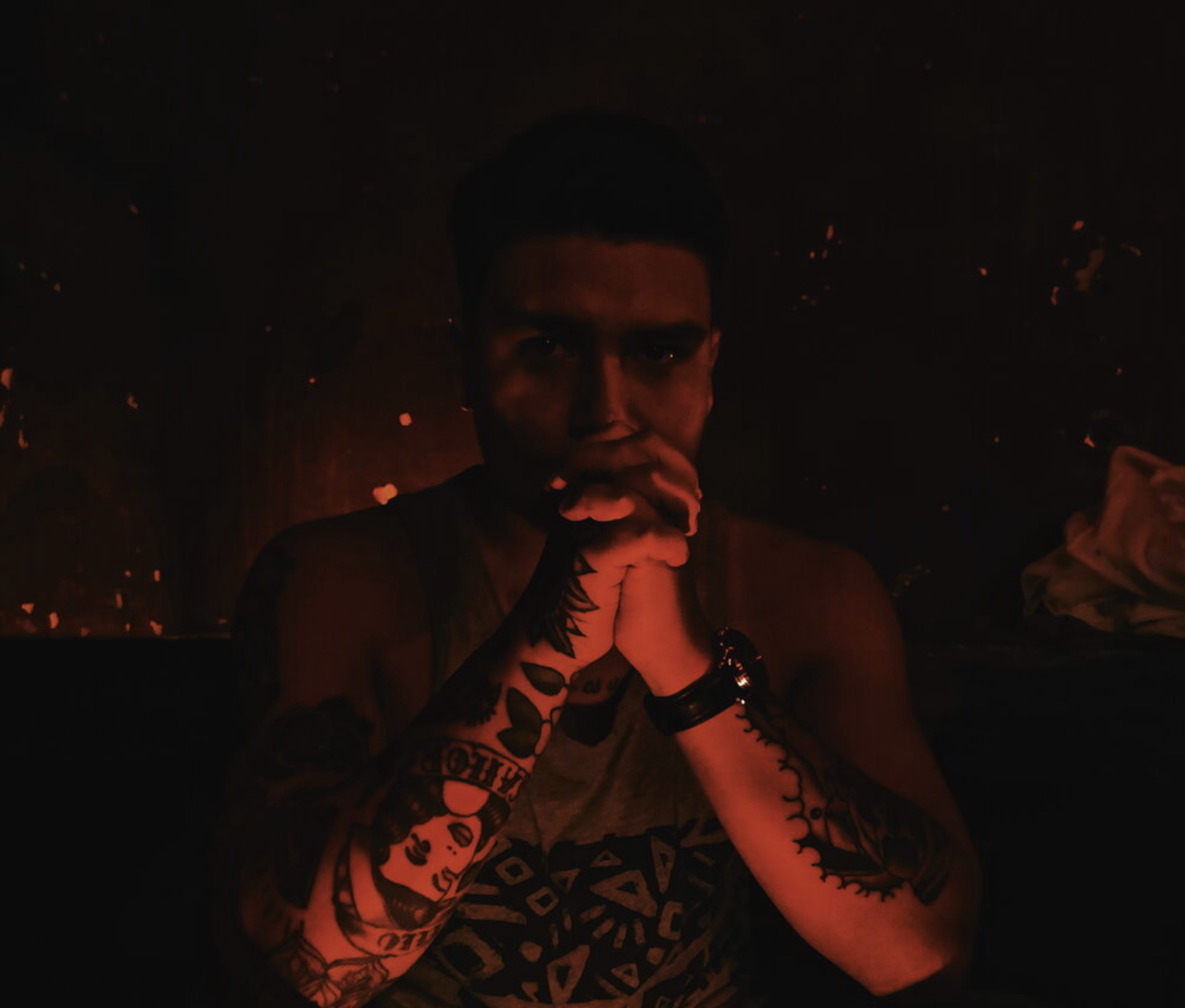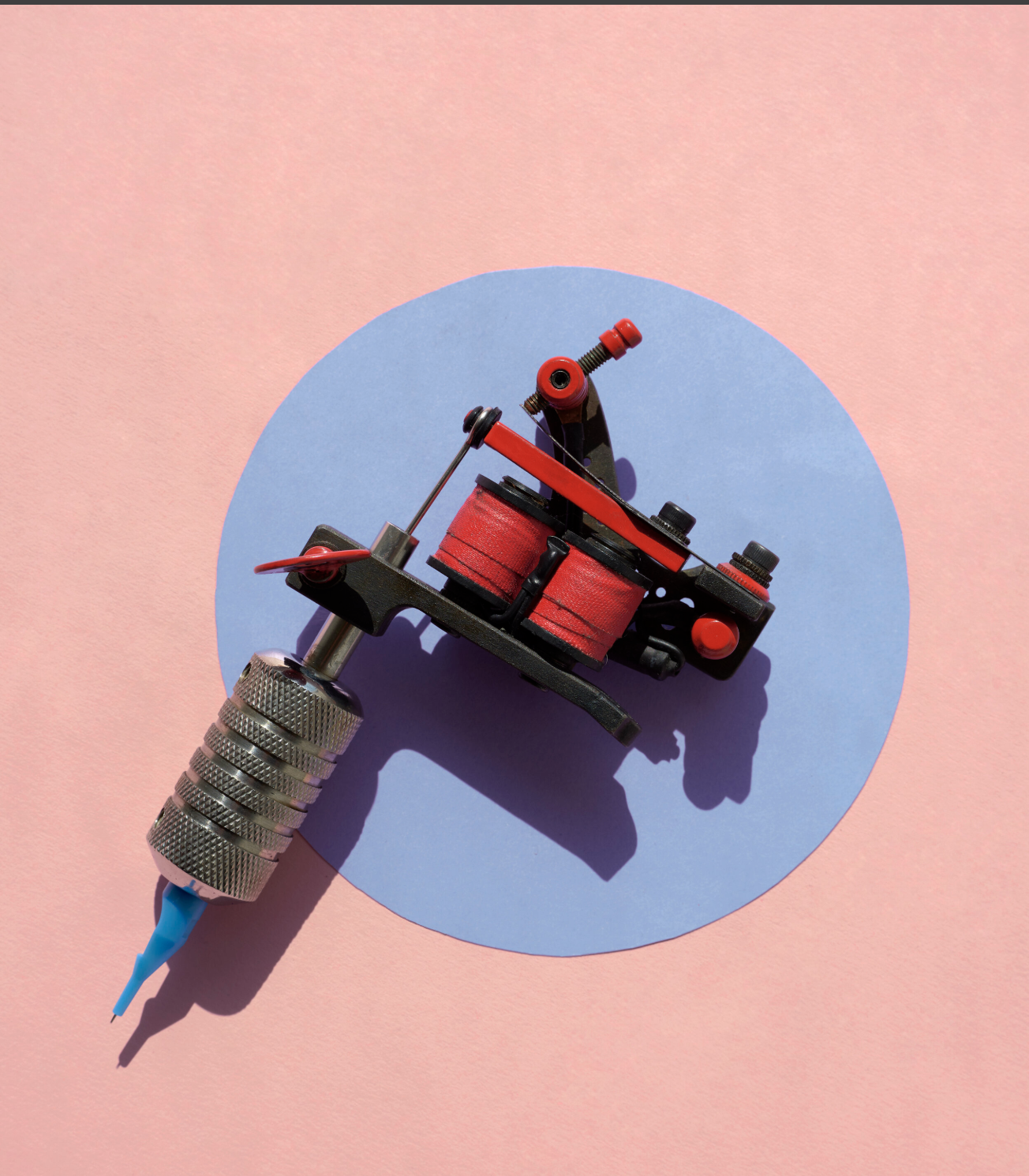Daddy Issue: What Tattoos Mean in the Face of Censorship
“What each tattoo is expressing is not really the interesting aesthetic value that’s being communicated. Rather, what is interesting about a tattooed body in public is that the tattooed body says ‘art is a democratic spectacle that has immediate, lasting impact on people’s lives.’ In other words, “art has consequences.”
by Woody Woodger
Pre-Op Thot is a biweekly column by Woody Woodger. “As a transgender anarcho-commie poetry slut, I’m here to derail the economy with my ethically sourced avocado toast and ruin every Thanksgiving with my colonialism PowerPoints. This column will have that same vibe, but I’ll jam poetry and Camus somewhere in there, and you can’t stop me. Through this column, I intend to do bite-sized deep dives into underrepresented aspects of the contemporary Zeitgeist, grounding my discussion with theory, research, and poetry that I think relative to each topic. But don’t worry, it won't all be fun. My teachers, Youtube commenters, and therapist all say my writing is a “huge bummer.” So if you're looking for a column that says “Last-Week-Tonight-but-make-it-discount-Contrapoints”, I’m your gal. So good luck out there, Gorge! God’s dead, smash the patriarchy and remember sunscreen. Love you!”
On my manhood rests a tattooed
portrait of Mr. President
My beloved found that out after
we wed
She was utterly gutted,
Inconsolable.
–Image, by Maung Saunghkha
Rarely is poetry so cocky. Myanmarese poet Maung Saungkha was convicted of defamation and sentenced to six months of jail time for posting his poem “Image” to his Facebook account that ridiculed then-President Thein Sein.
The poem is short, pointed, and cheeky. Fun, some might argue. What’s better is that according to a short blog post on Poetry Foundation’s Poetry News section, Saungkha claims he does not even have the tattoo, but “that he was inspired to write the poem by the images of political heroes like Ms. Aung San Suu Kyi that some supporters have inked on their bodies.”
What’s important to know is, at the time, Myanmar was a fledgling domacracy, only transitioning to an electoral system in 2011, and even the idea that it became fully democratic over night is contested. Thein Sein was Mayanmar’s first democratically elected president and, as Joe Freeman from The New Yorker says in his article covering Saungkha’s incarceration and trial, “One of the ironies of life under an authoritarian government is that it can be easier to navigate what is and is not permissible than it is when freedom comes.”
What so interests me is not if Saungkha has the tattoo, but how one little poem can cost a person 6 months of their life. Or more specifically, how in a poem, a tattoo, any piece of art, the value might not necessarily be just in the piece itself. Rather, sometimes the value, the cost of a piece of art may be in what happens to the actual humans connected to it.
Nowhere does art’s cost make itself more apparent than when I’m getting another one of my tattoos. My father does not like tattoos, which is roughly 40 percent of the reason I have so many. But obvious daddy issues aside, tattoos are a relatively new interest for me as they seem to be for the mainstream American culture.
Though their mainstream proliferation and acceptance is a relatively recent phenomenon, tattoos have a long and cultured story that has woven itself into the fabric of just about every society on record, and has endured and evolved to be one of histories most varied, dynamic, and heretical art forms.
But tattoos and their rich and cultural history, no doubt full of wonder and insight, is not what this digression is focused on. No, this digression is about why one of the arguments my dad trots out when he warns me against another tattoo is generally unsound and ultimately misses a deeper truth about implicit responsibilities inherent in capitalist commodification and how those responsibilities effect us as art consumers.
Myanmarese poet Maung Saungkha was convicted of defamation and sentenced to six months of jail time for posting his poem “Image” to his Facebook account that ridiculed then-President Thein Sein. Photo courtesy of The Daily Beast.
What so interests me is not if Saungkha has the tattoo, but how one little poem can cost a person 6 months of their life. Or more specifically, how in a poem, a tattoo, any piece of art, the value might not necessarily be just in the piece itself. Rather, sometimes the value, the cost of a piece of art may be in what happens to the actual humans connected to it.
Nowhere does art’s cost make itself more apparent than when I’m getting another one of my tattoos. My father does not like tattoos, which is roughly 40 percent of the reason I have so many. But obvious daddy issues aside, tattoos are a relatively new interest for me as they seem to be for the mainstream American culture.
Though their mainstream proliferation and acceptance is a relatively recent phenomenon, tattoos have a long and cultured story that has woven itself into the fabric of just about every society on record, and has endured and evolved to be one of histories most varied, dynamic, and heretical art forms.
But tattoos and their rich and cultural history, no doubt full of wonder and insight, is not what this digression is focused on. No, this digression is about why one of the arguments my dad trots out when he warns me against another tattoo is generally unsound and ultimately misses a deeper truth about implicit responsibilities inherent in capitalist commodification and how those responsibilities effect us as art consumers.
"… Tattoos have a long and cultured story that has woven itself into the fabric of just about every society on record, and has endured and evolved to be one of histories most varied, dynamic, and heretical art forms. But tattoos and their rich and cultural history, no doubt full of wonder and insight, is not what this digression is focused on.”
(Yes, this essay is an excuse to preform some more-than-quasi Marxist, petty, liberal pwnage on my dad, who is really quite a nice guy. Yeah, I also don’t think it shouldn’t have been published, but, hey, you made it this far and cognitive dissonance says if you stop reading now you’ve wasted your valuable time as a consumer and thus have impinged upon your possible personal attainment in the behemoth conveyer-belt that is our capitalist nightmare, so read on.)
Let’s jump right in—
One Argument My Fathers Uses to Argue Against the Procurement of Tattoos:
Premise 1: Tattoos are a virtually permanent, drastic change to one’s body.
Premise 2: Tattoos are a form of recognizable, measurable art.
Premise 3: All art costs a price to obtain, whether that be monetary, emotional, social, temporal, etc.
Assumption 1: Tattoos and all other forms of art serve the same recognizable, measurable cultural significance.
Assumption 2: All other forms of art (sculpture, painting, listening to music, reading a poem) do not require the same or greater level of cost as a tattoo.
One Argument My Fathers Uses to Argue Against the Procurement of Tattoos:
Premise 1: Tattoos are a virtually permanent, drastic change to one’s body.
Premise 2: Tattoos are a form of recognizable, measurable art.
Premise 3: All art costs a price to obtain, whether that be monetary, emotional, social, temporal, etc.
Conclusion: Woody, Wouldn’t it just be easier to buy a painting than get another flower on your arm forever?
Really, he should be lucky I don’t have a president on my penis. Regardless, dad makes a valid point: why do I decide to get a honeysuckle stabbed into my forearm for 6 hours at $100 an hour when I could just as easily go to a Goodwill and pick up some hotel art for $6 – probably exponentially larger than the flower on my forearm?Excluding value, my dad might add, buying a painting is far less physically painful, nor is it permanent. If, in 45 years, you don’t like the hotel art, then you can put it in an attic somewhere and never have to deal with it again. With that flower, he’d say, you have to own that flower for the rest of your life.
I think in many ways, my dad is right about the cost of tattoos. The cost to the owner’s body and wallet, the time loss, all valid. But then we might say, well, it’s not as if that monetary and time cost is exclusive to tattoos. All art takes time and money to make or purchase. And as for the pain, some people find the pain an integral part of the tattoo itself, a necessary part of the tattoo medium.
Beyond the problems of the cost, we may have more luck pwning my dad on the metaphysical claim he makes when he says you can remove a painting from a wall, but a tattoo is forever. I think this may be true to some degree. You could grow to hate a painting you bought years ago and remove it from your life—remove it, hide it, sell it, burn it, toss it to the salty-wet kiss of oblivion. And that’s true you could remove the material presence of the work of art, but will that destroy it? Say you physically destroy a piece as beloved as Starry Night or a piece as replicated as the Mona Lisa? Could you ever remove the emotional and tangible impact of those works? Regardless of the physical art product, one has to deal with the art as addition to the historical art record. In that way they are what I’ll call “Art”ifacts—the immaterial, irremovable, historical, emotional resonance that a piece of art elicits by virtue of its being made.
But even if we preclude famous works that have taken on a life of their own – what about the hotel painting from the thrift store that evokes nothing but apathy? What about those Hansel-and-Gretel ceramic salt and pepper shakers that are at every Goodwill ever and come alive at night to feast? Well, they evoke absolutely nothing, or the unquenchable desire to send them back to the hell fire they were forged from, respectively. Regardless, the art still had recognizable, tangible, worldly affect. If we were to destroy them (if Hansel can be destroyed) then their action as an “Art”ifact still exists. In this way, we can see art’s truth value (that is the “Art”ifact's physical being) is no longer necessary to its value after its production. What’s necessary is there having been an artist to make the work and an audience to have consumed it.
“But even if we preclude famous works that have taken on a life of their own – what about the hotel painting from the thrift store that evokes nothing but apathy? What about those Hansel and Gretel ceramic salt and pepper shakers that are at every Goodwill ever and come alive at night to feast?”
And with the idea of the “Art”ifact in mind, we can see the tattoo is just more honest about the art as a ritual, as a historical fragment, as a commodity, as an “Art”ifact. The act of getting the tattoo physically etched into you—you, a social being—say to others in the world, “Here is what I value aesthetically. And, yes, what I value aesthetically is ‘how cool would elbows be if they also had cobwebs?’”But what each tattoo is expressing is not really the interesting aesthetic value that’s being communicated. Rather, what is interesting about a tattooed body in public is that the tattooed body says “art is a democratic spectacle that has immediate, lasting impact on people’s lives.” In other words, “art has consequences.”
Saungkha understands consequences better than most arts. According to Freeman in his New Yorker article, “Saungkha turned twenty-four on January 5th,” right in the midsts of his trial and incarceration, “…and Saungkha’s supporters held a little party for him at the courthouse after the hearing. There was cake and presents. Somebody bought a cage full of small birds. Saungkha opened the door and symbolically freed them; they flitted through the barbed wire.” I love this moment in the article. So lyrical and tender. A poetic moment Saungkha never even intended to share.
“Image” is itself sparse, relying almost totally on the humorous turn to cary all the poetic weight. It’s crass, limerick-like, and yet profound with its treatment of exploitative politics. The speaker emasculates The President in the poem by emasculating himself. The President in this poem seems to be portrayed as an autocrat, a strongman, a dominator, the political equivalent of a phallus—as posed by the poem. But rather than being the virile, masculine, conquering face of his country, the poem ends with the speaker’s wife rejecting the presidential phallus, thus orientating The President as cartoonish, unattractive, castrated, and something to reject and shame.
“What we have here is Thein Sein proving that what we’ve said about an “Art”ifact—that the sentiment and relationship between a piece of art and audience exists with or without the work—through his repression of something so seemingly trivial as a Facebook poem.”
Additionally, we get the feeling that this autocratic, strongman aesthetic is one the speaker found attractive, an aesthetic the speaker wanted to adopt and publicly endorse, only to have this wife reject his misguided attempt to literarily embody the literal image of power. The fact that The President’s face is on the “manhood” of one of his citizens is the direct cause of the citizen’s—the speaker’s—emasculation suggests that The President’s hyper-masculine automatic tendencies are degrading and shameful for all the men of the country, leaving a permanent stain (the tattoo) on every individual. It’s this transitive shame shared between the men of Myanmar and their hyper-masculine president, and the shame shared between the wife and the speaker (and by extension the president), that Saungkha intends to highlight.
And I think this use of relationships gives us insight into why this poem became a target for President Thein Sein. While the comedy of the piece may be cutting, what’s most powerful about the poem (and probably the aspect of the poem that landed Saungkha in prison) was how the poem so efficiently remarks on relationships and how art itself (in the poem illustrated by the tattoo) can immediately create a relationship with the audience. What we have here is Thein Sein proving that what we’ve said about an “Art”ifact—that the sentiment and relationship between a piece of art and audience exists with or without the work—through his repression of something so seemingly trivial as a Facebook poem. The autocrat, even a democratically elected autocrat, knows that art is an existential danger.
Soon that existential danger would spread to all of Myanmar, and the fact this trial was held over a Facebook post seems down right prophetic now. Thanks in large part to the disinformation spread and largely allowed by Facebook, the Rohingya Muslim minority group in Myanmar have become the target of ethnic cleansing according to the UN. The murders, rapes, and suffering of the group are untold. It appears the cleansing was a concerted effort by Myanmarese military, and that the concerted effort of the Myanmar government during Thein Sein’s Presidency.
I feel sick spending this essay musing on my 101 philosophizing, daddy issues, and made-up word. Relegating the Rohingya Muslims’ suffering to that small paragraph is unacceptable, but I hope this fragment calls attention to the foundation of terror that belies Saungkha’s little act of rebellion. Thein Sein’s engaged with fear, the military with hate. Facebook thought genocide itself was engaging, profitable.
I think poets are made to feel antiquated, frivolous. Maung Saungkha disagrees. He founded ATHAN and works to rebuild relations between Buddhists and the Rohingya Muslims through poetry. Saungkha’s contemporary humanitarian work took some digging to find. His penis tattoo was far more accessible.
Here’s a son about to lecture father about why his tattoos and father about to regret sending him to college. (I know I'm trans. I looked for daughter lectures dad on google and got the cultural equivalent of a 404 error.)
Woody Woodger lives in Lenox, Massachusetts. Her work has appeared, or is forthcoming, from DIAGRAM, Drunk Monkeys, RFD, Exposition Review, peculiar, Prairie Margins, Rock and Sling, and Mass Poetry Festival, among others, and her poetry has been nominated for Best of the Net. Her first chapbook, “postcards from glasshouse drive” (Finishing Line Press) has been nominated for the 2018 Massachusetts Book Awards. In addition, Woodger served as Poet in Residence with the Here and Now in Pittsfield MA. She is a poetry reader for COUNTERCLOCK Journal. In this column, she intends to do bite-sized deep-dives into underrepresented aspects of the contemporary Zeitgeist, grounding her discussions with theory, research, and poetry relative to each topic. So if you're looking for a column that says “Last-Week-Tonight-but-make-it-discount-Contrapoints,” she’s your gal.









